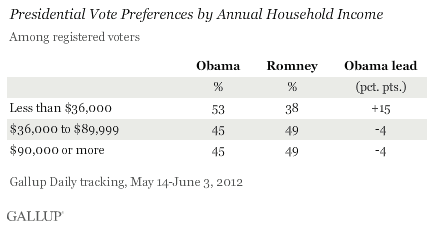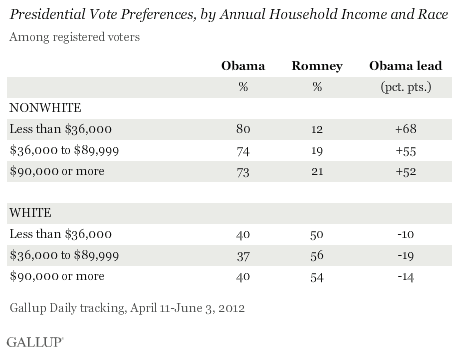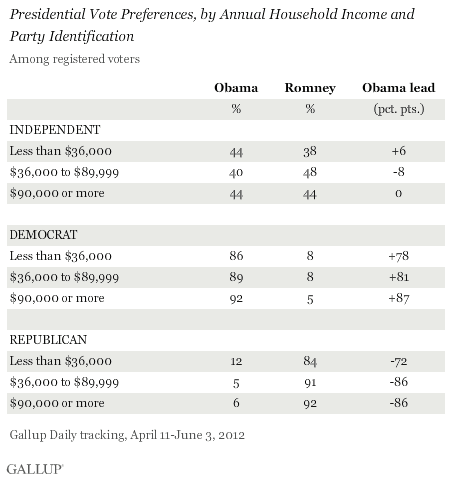PRINCETON, NJ -- Mitt Romney currently has a 49% to 45% edge over Barack Obama among middle-income voters, those whose annual household income is between $36,000 and $89,999. Romney has the same lead among upper-income voters, while Obama maintains a wide advantage among lower-income voters.

The results are based on Gallup Daily tracking of 2012 election preferences by demographic group, including more than 9,000 interviews with registered voters conducted between May 14 and June 3. During this period, Obama and Romney were tied at 46% among all registered voters.
Voting preferences by income group have been fairly well-established since Gallup began tracking the general election on April 11. Obama's lead over Romney among low-income voters has ranged between 13 and 16 percentage points in each of the three-week rolling averages of the vote by demographic group that Gallup has reported since late April. Meanwhile, Romney's edge among middle-income voters has been between four and seven points, and among upper-income voters, between four and six points.
Romney, the wealthy former head of Bain Capital, has slightly greater appeal to the highest-income voters in Gallup's data, those making $180,000 or more in annual income. This group has shown a 53% to 42% preference for Romney since mid-April, compared with 50% to 45% for Romney among those earning between $90,000 and $179,999.
Race a Factor in Obama Support Among Lower-Income Voters
In each of the three major income groups Gallup reports, there are strong racial divides in voting preferences. Non-Hispanic whites and nonwhites show stark differences in their candidate preferences.
In Gallup tracking since April 11, Romney is the leader among whites in all income groups, including those who are lower income. At the same time, Obama has a commanding lead among nonwhites in all income groups.

Obama's large lead among low-income voters overall is due to two factors. First, as the prior table shows, lower-income nonwhites prefer Obama to Romney by a 68-point margin, compared with smaller 55-point and 52-point margins among middle- and upper-income nonwhites, respectively. At the same time, Romney has a smaller lead among lower-income white voters (10 points) than among middle- (19 points) or upper-income white voters (14 points).
Second, and perhaps more importantly, nonwhites fall disproportionately into the lower-income group. Nearly half of nonwhites, 49%, report annual household incomes of less than $36,000. And 38% of those in the lower-income group are nonwhite, compared with 22% of those in the middle-income group and 17% in the upper-income group.
Romney Leads Among Middle-Income Independents
Though Romney's edge among middle-income voters is similar to his lead among upper-income voters, in certain subgroups of middle-income voters he performs especially well. That includes middle-income independent voters, who right now prefer Romney by an eight-point margin, 48% to 40%. Obama leads among lower-income independents, and the two are tied among upper-income independents.

Romney and Obama predictably hold large leads, no less than 72 percentage points, among party supporters across the income spectrum.
Middle-Income Women Divided in Their Vote Choices
Much has been made in this campaign of the gender gap in voter preferences, with Obama faring better among women and Romney among men.
However, there are variations in the vote pattern by gender within income group.
Lower- and upper-income women show solid preferences for Obama. However, middle-income women are much more closely divided, with 48% favoring Obama and 45% Romney.

Whereas middle- and upper-income men show solid support for Romney, lower-income men show nearly equally solid support for Obama.
Implications
U.S. voters' 2012 preferences so far align with the perception of the Democratic Party as the party of the poor and the Republican Party as the party of the rich. Obama holds a wide lead among lower-income voters, in large part due to the high concentration of minority voters in this group, while Romney holds a smaller, but significant, edge among upper-income voters.
During the campaign, both presidential candidates will do their best to convince middle-income voters that their policies will be more beneficial to the middle class. So far, middle-income voters are more likely to support Romney than Obama. And within the middle-income group, Romney is running stronger among political independents and is competitive with Obama among middle-income women.
It will be especially important for Obama to improve his standing among middle-income voters because his large advantage among lower-income voters is offset to a degree by their lower level of voting participation. Gallup's tracking data show that an average of 69% of lower-income voters say they will "definitely" vote in the election this fall, compared with 83% of middle-income voters and 87% of upper-income voters.
Track every angle of the presidential race on Gallup.com's Election 2012 page.
Survey Methods
Results are based on telephone interviews conducted as part of Gallup Daily tracking May 14-June 3, 2012, with a random sample of 9,015 registered voters, aged 18 and older, living in all 50 U.S. states and the District of Columbia.
For results based on the total sample of registered voters, one can say with 95% confidence that the maximum margin of sampling error is ±1 percentage points.
For results based on the total sample of 2,393 registered voters living in households with less than $36,000 annual income, one can say with 95% confidence that the maximum margin of sampling error is ±3 percentage points.
For results based on the total sample of 3,285 registered voters living in households with annual incomes between $36,000 and $89,999, one can say with 95% confidence that the maximum margin of sampling error is ±2 percentage points.
For results based on the total sample of 1,803 registered voters living in households with $90,000 or more annual income, one can say with 95% confidence that the maximum margin of sampling error is ±3 percentage points.
Interviews are conducted with respondents on landline telephones and cellular phones, with interviews conducted in Spanish for respondents who are primarily Spanish-speaking. Each sample includes a minimum quota of 400 cell phone respondents and 600 landline respondents per 1,000 national adults, with additional minimum quotas among landline respondents by region. Landline telephone numbers are chosen at random among listed telephone numbers. Cell phone numbers are selected using random-digit-dial methods. Landline respondents are chosen at random within each household on the basis of which member had the most recent birthday.
Samples are weighted by gender, age, race, Hispanic ethnicity, education, region, adults in the household, and phone status (cell phone only/landline only/both, cell phone mostly, and having an unlisted landline number). Demographic weighting targets are based on the March 2011 Current Population Survey figures for the aged 18 and older non-institutionalized population living in U.S. telephone households. All reported margins of sampling error include the computed design effects for weighting and sample design.
In addition to sampling error, question wording and practical difficulties in conducting surveys can introduce error or bias into the findings of public opinion polls.
For more details on Gallup's polling methodology, visit www.gallup.com.
